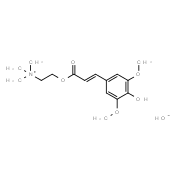Sinapine hydroxide
Modify Date: 2025-08-27 00:55:45

Sinapine hydroxide structure
|
Common Name | Sinapine hydroxide | ||
|---|---|---|---|---|
| CAS Number | 122-30-5 | Molecular Weight | 327.37 | |
| Density | N/A | Boiling Point | N/A | |
| Molecular Formula | C16H25NO6 | Melting Point | N/A | |
| MSDS | N/A | Flash Point | N/A | |
Use of Sinapine hydroxideSinapine hydroxide is an alkaloid isolated from seeds of the cruciferous species. Sinapine hydroxide exhibits anti-inflammatory, anti-oxidant, anti-tumor, anti-angiogenic and radio-protective effects. Sinapine hydroxide is also an acetylcholinesterase (AChE) inhibitor and can be used for the research of Alzheimer’s disease, ataxia, myasthenia gravis, and Parkinson’s disease[1][2][3][4]. |
| Name | Sinapine hydroxide |
|---|
| Description | Sinapine hydroxide is an alkaloid isolated from seeds of the cruciferous species. Sinapine hydroxide exhibits anti-inflammatory, anti-oxidant, anti-tumor, anti-angiogenic and radio-protective effects. Sinapine hydroxide is also an acetylcholinesterase (AChE) inhibitor and can be used for the research of Alzheimer’s disease, ataxia, myasthenia gravis, and Parkinson’s disease[1][2][3][4]. |
|---|---|
| Related Catalog | |
| Target |
AChE[4], P-gp[1] |
| In Vitro | Sinapine (6 or 60 μM; 1 h) counteracts H2O2 and antimycin A-induced mitochondrial oxidative stress in cardiomyocytes[1]. Sinapine (10-200 μM; 24 h) inhibits the proliferation of Caco-2 cells in a dose-dependent manner, and has relatively low toxicity[3]. Sinapine (10-200 μM; 24 h) promotes doxorubicin accumulation in Caco-2 cell by inducing P-glycoprotein (P-gp) decrease[3]. Sinapine (10-200 μM; 24 h) significantly reduces phosphorylation of FRS2α, ERK1/2[3]. |
| In Vivo | Sinapine reduces non-alcoholic fatty liver disease in mice by modulating the composition of the gut microbiota[2]. |
| References |
| Molecular Formula | C16H25NO6 |
|---|---|
| Molecular Weight | 327.37 |